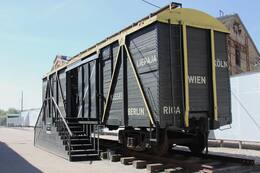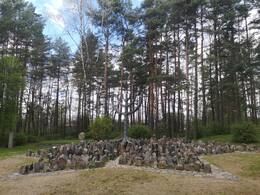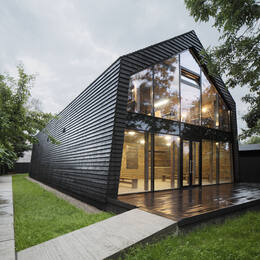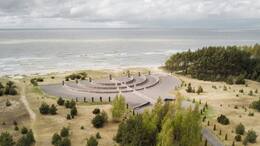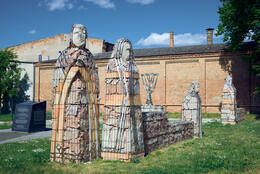Riia geto ja holokaust
Teadlikult on valitud kolm fragmenti erinevate inimeste mälestuste lugudest, mis võimaldavad holokaustikuritegevust lähemalt vaadelda erinevatest vaatenurkadest.
Rumbula tegevust jälgis Saksa armee kindralmajor VALTER BRUNSS: Esikuuik püstolkuulipildujatega, mida seejärel tulistati pähe. Kui kohale jõudsin, oli see juba täis, elusad pidid peal lamama ja siis lasti maha; ruumi säästmiseks pidid nad tihedalt magama. [...] Kui nad lähenesid, nägid nad, mis toimub. [...] Nad pidid oma ehted ja kohvrid tagastama. Head asjad sattusid kohvritesse ja ülejäänu - ühes suures hunnikus, veidi kaugemal, tuli lahti riietuda ja 500m enne metsa tuli täielikult lahti riietuda, jääda sai vaid särgi või aluspükste sisse. Nad kõik olid naised ja väikesed lapsed, umbes 2-aastased.
JANIS LIPKE, juutide päästja: Tekkis tõeline kaos: inimesed tormasid abitult ühest kohast teise, karjusid, nutsid. Ühed venitasid mõnda kimpu ja kohvreid, teised tassisid või lükkasid vankris lapsi. Purjus politseinik karjus inimeste peale, tõmbas nad korteritest välja ja peksis jõhkralt läbi. Mõned oravad tulistasid rahvahulka, vaadates rahvahulka. [...] Saksa sõdurid ja Läti politsei peksid ja lasid maha kolonni taha jäänuid. Hukkunute surnukehad jäid tänavale, mis viis inimesed tulistamisele. Nägin suure maja hoovis palju naisi ja beebisid. Maja asus Lāčplēša tänaval okastraataia kõrval, mis oli ümbritsetud getoga”
Riia geto vang BEIL HAMBURG elas Rumbula kampaania üle: «Inimesed liikusid aeglaselt edasi, politsei helistas «kiiremini, kiiremini», aga miski ei aidanud. Muutusime ükskõikseks, elutahe kadus. Kõndisime mööda Maskavas tänavat, inimesed seisid akende juures ja vaatasid meid. Mõni pühkis silmi, aga nägin ka neid, kes naersid. Üks näitas isegi rusikat. Jõudsime linna servas asuva kummivabriku "Square" juurde ja läksime edasi, kuni kuulsime palju lasku. Nüüd nutsid lapsed kõvasti. Politsei oli juba purjus ja utsitas ainult "kiiremini, kiiremini".
Kindralmajor Walter Bruns (1891 - 1957) oli 1941. aasta lõpus Riia lähedal asunud Saksa sõjaväe insener-polkovnik, kes oli Rumbula veresauna tunnistajaks. Ta arreteeriti 8. aprillil 1945 ja viibis Briti Saksa ohvitseride kinnipidamislaagris. Need kinnipidamiskeskused olid varustatud ülekuulamisseadmetega, nii et vangide vestlused salvestati ja salvestati. Ühes sellises vestluses Brunsi ja teiste ohvitseride vahel rääkis ta sündmustest Rumbulas, andes tunnistust holokaustist Riias. 1948. aastal andis Bruns kohtus tunnistajana Wehrmachti ülemjuhatuse vastu tunnistusi. Samal aastal vabanes ta vanglast.
Žanis Lipke (1900 - 1987) oli Riia sadama dokitööline. Kui natsid Riia okupeerisid, tahtis ta juudi kogukonda aidata. Selleks sai ta tööle Riia geto lähedal Keskturu lähedal asuvatesse Luftwaffe ladudesse. Ta pidi juhatama juudid ladudesse ja sealt tagasi. Lipke kasutas seda juhust, et osa juute varjata ja nad ei peaks enam getosse tagasi pöörduma, vaid võisid minna Lipke majja, kus ta oli neile juba punkri ette valmistanud. Hiljem leidis Žanis Lipke Riiast ja Dobelest tuttavate eest teisigi kohti juutide peitmiseks. Kokku päästis Žanis Lipke koos abilistega üle 50 inimese.
Baille oli Riia geto vang, kes elas üle Rumbula kampaania. Suri Stutthofi koonduslaagris
Mälestused on avaldatud Läti Okupatsioonimuuseumi kodulehel. Saadaval: http://okupacijasmuzejs.lv/rumbula/
Seotud teemad
Seotud objektid
Riia Geto- ja Läti Holokaustimuuseum
Riia Geto- ja Läti Holokaustimuuseum asub Riias keskturu ja pearaudteejaama läheduses. Muuseum avati 2010. aastal kohas, kus kunagi asusid linna laod. See on rajatud ajaloolisse linnaosasse, mis piirnes endise juudigetoga. Geto ala on ainulaadne, sest arhitektuuriliselt ei ole see pärast Teist maailmasõda muutunud. See on mälestuspaik juudi rahva tragöödiale. Natsi-Saksamaa poliitika Läti juudi elanikkonna suhtes seisnes 1939. aasta lõpuni selles, et Saksa diplomaadid ja poliitikud üritasid avaldada survet Läti valitsusele juudivastaste meetmete rakendamiseks ja nende vabaduse piiramiseks. Pärast baltisakslaste lahkumist 1939. aastal ei olnud Saksa saatkonnal enam nii head ülevaadet elanikkonna meelsuse ja Lätis toimuva kohta. Kui Punaarmee okupeeris Läti ja hakkas ühiskonnaga manipuleerima, toetas osa juudi elanikkonnast uut okupatsioonivõimu. Pärast seda, kui režiim pöördus terve ühiskonna vastu, langes toetus kiiresti. Ometi oli tekkinud sügav lõhe elanikkonnas, mida püüdis hiljem ära kasutada järgmine okupatsioonirežiim, Natsi-Saksamaa. See lootis, et kohalik elanikkond ahistab ja ründab juute, kuid seda ei juhtunud. Saksamaa töötas välja uue plaani, mis alguses nägi ette Riia geto loomist, aga hiljem hävitas selle elanikud.
Juudi mälestusmärk Rumbulas
Asub Rumbulas Moskava tänava lähedal.
Rumbula on üks suurimaid juutide massilise hävitamise kohti Euroopas. Kahe aktsiooni ajal – 1941. a. 30. novembril ja 8. detsembril, mis realiseerusid natside juhtkonna otsusel Riia getos vangistatud juudid täielikult hävitada, lasti Rumbula metsas maha üle 25 000 inimese, sealhulgas ligikaudu 1000 Saksamaalt küüditatud juuti. 1944. aastal Rumbulas tapeti ka mitusada juudi meest Kaiserwaldi koonduslaagrist.
Esimesed katsed Rumbulas tapetud juutide mälestust jäädvustada pärinevad 60. aastate lõpust. Vaatamata Nõukogude valitsuse piirangutele mõnede juutide initsiatiivil 1963. a. ühele Rumbula männile kinnitati jidišikeelse kirjaga puidust mälestustahvel, Rumbula raudtee äärde (Riia-Moskva liini lähedusse) aga kunstnik Josif Kuzkovskise suur plakat "Juut". Plakatil oli hauast rusikasse surutud mehe kujutis, mis sümboliseerib protesti tehtu vastu. Nii mälestustahvel kui plakat juba 1964. aastal. koristati, kuid juutidel õnnestus saada luba Rumbulasse mälestuskivi püstitamiseks mitte ainult läti- ja venekeelse, vaid ka jidišikeelse kirjaga "Fašismi ohvrid".
aastal 2002 29. novembril avati Rumbulas memoriaalansambel arhitekt Sergejs Riži projekti järgi. Selle loomist toetasid rahaliselt Läti, Iisraeli, USA ja Saksamaa institutsioonid ning eraisikud.
Kiirtee äärde, memoriaali juurde viiva tee äärde on märgiks paigaldatud natsismijõude sümboliseeriv metallkonstruktsioon. Lähedal on kivi seletusega, et seda teed mööda aeti surnuks tuhandeid juute. Mälestusmärgi enda sissepääsu juures on mitmed läti-, inglise-, saksa- ja heebreakeelsete kirjetega kivitahvlid tutvustavad Rumbula tragöödia sündmusi ja mälestussamba rajamise ajalugu. Mälestusmärgi keskosas, Taaveti tähe kujulise väljaku kohal kõrgub seitsmeharuline küünlajalg - menora, mida ümbritsevad kivid, millele on graveeritud Rumbulas tapetud juutide nimed. Endise Riia geto tänavate nimed on raiutud üksikutesse kividesse, millega plats on sillutatud. Mälestusmärgi territooriumil on mitu ühishauda, mille kohad on tähistatud ristkülikukujuliste betoonpiiretega.
Žanis Lipke memoriaalansambel
Žanis (Janis) Lipke memoriaalansambel asub Riias Ķīpsalas. Žanis Lipke Muuseum on tõenäoliselt üks Riia peidetumaid muuseume. Memoriaali varjatud asukoht ei ole juhuslik ja sellel on sümboolne tähendus. See on rajatud kohta, kus Teise maailmasõja aegse Saksa okupatsiooni ajal asus maa-alune peidupaik inimeste päästmiseks. Siin päästsid Žanis Lipke ja tema perekond 55 juuti. Praegune memoriaal on rajatud Žanis Lipke perekonna maja juurde. Memoriaalehitis „Must kuur“ on sümboolne hoone, kus pakuti ja saadi varju. Hoone kujundamisel on saadud inspiratsiooni Ķīpsala kalurite ja meremeeste ajaloolistest tõrvatud hüttidest, mille ehitamisel kasutati pargastest saadud materjale. Seetõttu oli neil väga eripärane värv ja tõrvalõhn. Ainulaadne ei ole ainult selle paiga lugu, vaid ka viis, kuidas muuseum oma külastajatega suhtleb. Üldisel kujundusel on sarnasusi Piiblis kirjeldatud Noa laevaga, samuti meenutab see kaldale tõmmatud ja ümber pööratud paati, mis on oma ülesande täitnud. Memoriaalansambli kontseptsioon tugineb koha ja loo tõesusele ja nendega seotud mälestusesemetele. See on lugu inimese vabadusihast, uskumatust põgenemisest ja usaldusest. Teel muuseumisse on võimalik tutvuda ka Pārdaugava ajaloolise hoonestusega.
Holokaustiohvrite memoriaalansambel Liepājas
Läti suurim holokaustiohvrite memoriaalansambel asub Liepājas Šķēde liivaluidetes. Memoriaalansambel on pühendatud rohkem kui 3000 Liepāja juudi mälestusele, kes tapeti Teise maailmasõja ajal. See on Iisraeli rahvussümboli menoraa ehk 7-harulise küünlajala kujuline. Memoriaali kontuur, mida on hästi näha linnulennult, on valmistatud lõhutud kivirahnudest ja graniitplokkidest. Menoraa tuled on valmistatud graniitsammastest, millele on raiutud heebrea, inglise, läti ja vene keeles värsid Jeremija nutulauludest.
Mälestusmärk "Sünagoogi aed"
See asub Bauska kesklinnas, Bauska piirkonna turismiinfokeskuse, Raekoja platsi lähedal.
Mälestusmärk "Synagogas dārzs" sündis tänu Bauska juudi järeltulijate initsiatiivile Iisraelis, USA-s ja Suurbritannias, annetustele, Bauska maanõukogu, Läti juudi koguduste ja kogukondade toetusele.
Mälestusmärgi kujundas skulptor G. Mustkunstnik, kes on ka V. Plūdonise monumendi autor. Mälestusmärk loodi endise Bauska Suure sünagoogi mõõtmetes, kivifiguurid sümboliseerivad pärast jumalateenistust sünagoogist väljuvaid juute. Mälestusmärgi keskel on sümboolne bima, millele on kirjutatud: "Pühendus Bauska juutidele, kes elasid siin sajandeid ja ehitasid selle linna ning kelle tapsid natsid ja nende kohalikud abilised 1941. aastal." Juudi rahva – Bauska juutide järeltulijate ja Bauska elanike mälestuse austamine. 1935. aastal elas Bauskas ligi 800 juuti. Pärast natside okupatsiooni juulis 1941 arreteeriti, küüditati palju juute ja umbes 700 lasti maha. Bauska Suur sünagoog hävis Teise maailmasõja ajal.





